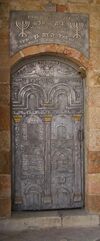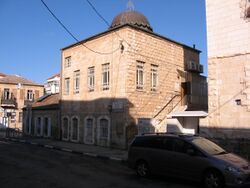Religion:Beit El Synagogue
Beit El Synagogue ("House of God" synagogue), (also Midrash Hasidim [School of the Devout] and Yeshivat haMekubalim [Yeshiva of the Kabbalists]) is a center of kabbalistic study in Jerusalem. After 1948, it was rebuilt in the Ruhama neighbourhood of West Jerusalem. In 1974, a new branch opened in the Old City.
History
- For the Religious Zionist Yeshiva in the yishuv of the same name, see Beit El Yeshiva,
The yeshiva was founded in 1737 by Rabbi Gedaliah Hayon, originally from Constantinople, for the study of kabbalah in the Holy City. In the 1740s, a gifted young man named Shalom Mizrachi Sharabi arrived in Jerusalem from Yemen. He studied at Beit El and over time became an outstanding scholar and kabbalist. At the behest of Rabbi Hayon, he was appointed head of the yeshiva.[1]
Under Sharabi’s leadership the yeshiva grew and became one of the main yeshivas in Jerusalem with 40 scholars from the Sephardic and Ashkenazi communities. Rabbi Hayon had organized the life of the yeshiva around prayer services, which through mystical communion with God would bring the scholars closer to understanding the secret teachings of Kabbalah. Rabbi Sharabi initiated regulations, orders and kavanot ("intentions") of the daily prayers according to the Nahar Shalom prayer book (Salonika, 1806/5566) which he authored, continuing the teachings of the Arizal and following its cosmological approach while incorporating kabbalistic symbolism, entreaties and thoughts/meditations. Known today as the Siddur haRashash, it remained, together with the Etz `Haim of Rabbi `Haim Vital, the focus of kabbalistic studies in the yeshiva.
The scholars were divided into four groups. The first awoke at midnight to say Tikkun Hatzot and learn the Kabbalah of the Arizal until dawn. The second delved into the works of the Arizal from after shacharit (morning prayers) until midday. The third group learnt the Mishna with Rabbi Ovadia mi’Bartenura’s commentary from midday till nightfall. After ma’ariv (evening prayers) the fourth set of scholars would arrive and learn the Talmud and the Shulchan Aruch.[2]
As the yeshiva's reputation spread it attracted prominent rabbis, among them were Chaim Joseph David Azulai, Avraham Gershon of Kitov, Menachem Mendel of Shklov and Yom Tov Algazi.
In 1757, Rabbi Sharabi chose twelve select disciples who were to form a special group called Ahavat Shalom (love of peace). They signed a pledge of eternal friendship which hung on the door of the Holy Ark in the synagogue. Part of the document reads: "..all twelve of us shall be as one glorious soul…that if God forbid one of us encounters misfortune, we will all assist him.." One of the stipulations was that if a son was born to one of the group, three members would go to learn Torah by the newborn's side every night until its circumcision to act as a safeguard for the child. On the night before the brit milah the whole group was instructed to visit and study there.
The synagogue premises remained in the hands of the leading kabbalists of each generation who inherited the apartment on the top floor.
In the late 1800s, the writings of Dr Eliezer Levy, who escorted Sir Moses Montefiore around Jerusalem, describe of how they visited the place where "they pray all year round according to the mystical meanings of the Arizal from midnight till the afternoon, and from then till the evening they study Talmud and Zohar." The authoritative Sefer Etz `Haim of Rabbi `Haim Vital was for the first time printed under the auspices of the yeshiva around 1866. Distinguished scholars of Kabbalah continued to emigrate to Jerusalem in order to study in the yeshiva. Among the outstanding luminaries, Rabbi Hayim Shaul Dweck HaKohen, Rabbi Shaul Kassin (the father of the famed leader of Syrian Jewry, Rabbi Yaakov Kassin), and Rabbi Avraham Ades (the master of the Baba Sali) were drawn there from Syria in order to dedicate themselves to spiritual growth.
New building (1928)
The July 1927 Jericho earthquake damaged the building and the British Municipality ordered the building be demolished. No sooner had the order been received, plans got underway to rebuild and eight months later in March 1928 the new extended premises were completed.
In the 1930s when the illustrious Chazon Ish was on his way to the Western Wall, he made a point of stopping by the synagogue to study there, stating “I have great merit to see the place where such great and holy people learnt and prayed”.[3]
During the 1947–1949 Palestine war the contents of the building were looted and the building was desecrated.[citation needed]
New City (1948) and Old City (1974)
The son of Rabbi Shalom Hedaya (who was head of Bet El from 1927 to 1945, following the leadership of Rabbi Yedidya Rafael Aboulafia and Rabbi Massoud Alhadad), Rabbi Ovadia Hedaya, set to work on schemes to revive the study of Kabbalah in the spirit of Bet El. Rabbi Ovadia Hedaya did so on the roof of his house on Rashi street before taking on the task in 1958 of rebuilding the yeshiva in the new section of the city on the very street where he lived.
In 1974, six years after the liberation of the Jewish Quarter, on the very site of the former Beit El Synagogue in the Old City, the Beit El Yeshiva was re-established (at first under the cryptic name Rishpei Esh,[4] as understood from the Shir haShirim) under the aegis of Rabbi Meir Yehuda Guez, a noted kabbalist, who until his death was the official rabbi of the Western Wall area. The Rashi Street yeshiva remains in existence.
On 13 September 1995, a ceremony took place celebrating the completion of refurbishment to the synagogue in the Old City, at this time it was also renamed Yeshivat HaMekubalim Beit El.[5] It was originally scheduled to take place in early 1996, but Rabbi Guez perceived that it should be brought forward. Upon Rabbi Guez's death his foremost student (talmid muvhaq) was chosen as Rosh Yeshiva of the Old City site.
One of the most famous alumni of the yeshiva was Rabbi Yitzchak Kaduri who died in January 2006. The Rosh Yeshiva Rabbi Shalom Mordekhai Haim Hedaya died in March 2010.[6] Rabbi Raphael Hedaya was appointed as caretaker Rosh Yeshiva of Beit El at the Rashi Street yeshiva until the year of mourning was passed.
The current Rosh Yeshiva of Beit El in the Old City is Rabbi Yisrael Avi`hai.
Rabbi Ovadia Hedaya found himself in dispute with Rabbi Yehuda Getz over the rejection by the latter of Shemen Sasson (the primary work of Rabbi Sasson Farsiyado).[7] The dispute led to the ultimate rejection of Rabbi Getz as a student of Rabbi Ovadia Hedaya. Rabbi Shalom Mordekhai Haim Hedaya also took issue with the newly founded Yeshiva in the Old City over the name, Yeshivat HaMekubalim Beit El.[8][9][10][11]
See also
References
- ↑ Where Heaven Touches Earth, by Rabbi Dovid Rossoff, Guardian Press, Jerusalem 1999.
- ↑ Sefer Chukei Chaim, by Rabbi Avraham Gagin.
- ↑ Sefer Chibas Yerushalayim, by Rabbi Chaim Horowitz, Jerusalem 1964.
- ↑ "Archived copy". Archived from the original on 2011-05-23. https://web.archive.org/web/20110523152757/http://www.queensu.ca/jewishstudies/kabbalah12.pdf. Retrieved 2008-03-18.
- ↑ Rav of the Kotel, by Simcah Raz, p. 455
- ↑ http://www.israelnationalnews.com/News/news.aspx/136643
- ↑ Deah V'Haskel Part 7, 16:13, Authored by Rabbi Ovadia Hedaya, published Jerusalem 1979.
- ↑ Introduction to Siddur HaKavvanot HaRaShaSh Vol 3, p 3, Midrash Ovadia 2008.
- ↑ Peticha Lilmud Kabbalah P. 132; Rabbi Benayahu Shmueli, Heikhla Drasbi 2010
- ↑ Shemen Sasson Introduction P10; Rabbi Meir Reindorf Kollel Shemen Sasson 2009
- ↑ Divrei Shalom Vol 1 Introduction P30, Rabbi Avner Afjin, Tzedek V'Shalom 2001
[ ⚑ ] 31°46′30″N 35°13′54″E / 31.774978°N 35.231566°E




